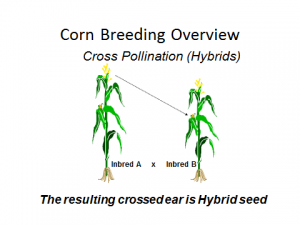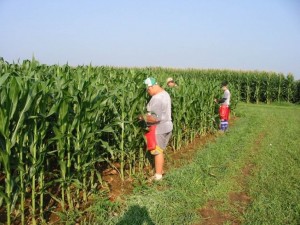July means pollinating season at Pioneer New Holland. The home research farm is broken up into three major sections. One section is the pollinating nursery, one section yield testing, and one section disease testing. All of the hand pollinations occur in the pollinating nursery at the home farm. The plant breeders who wish to cross some in-bred corn lines for the first time, or who want to self in-bred lines to reproduce similar material, have to control where the pollen goes from one plant to the other. When performing a self-pollination, pollen from the tassel of a corn plant is placed on the silks coming out of the ear shoot of the same plant. A cross pollination is done by taking the pollen from one plant and placing it on the silks of another plant.
To help with this work, the station brings in about 50 high-school kids to help with the hand pollinations for the 3 to 4 week long season. A big tent is set up with tables for lunch and break times. Porta-Potties, hand-washing stations, tables with water coolers, and trash cans are placed throughout the property to accommodate the extra workers. During the peak week of pollinating season, upwards of 10,000 pollinations may be done in a day. The “pollinators” as they are called arrive by 7:30 am and work until 3:00 or 4:00 pm. The interns start a little earlier as we were on water detail. The kids break into groups of 10 and each research assistant becomes a crew leader. The interns fill in as needed, helping pollinating crews, bringing supplies, helping set up and clean up. We also had a good bit of other data collection to do during this time so that kept us fairly busy.
Each day, the pollinators would go through a three step process. First thing in the morning, shoot bags would be placed on the emerging ear shoots. In a few days when the silks emerged, they would not be exposed to any pollen flying around in the open air. Second, everyone would “set up” on the tassels of plants. This involved placing a tassel bag over the tassels that were already shedding and losing anthers and pollen. Finally, the plants that were “set up” on the day before are “taken down” today. Tassel bags are taken off the plant after being shaken to capture more pollen. They are placed on the silks of the same or a different plant after the ear shoot bag is removed. The tassel bags with the pollen in them are then shook over the ear shoots and fastened around the stalk so as not to expose the silks or pollen. This is how pollinations are done and repeated over the entire pollinating nursery. In crossing blocks, pollen is taken from one set of male plants to another set of female plants in a different block.
A lot of pollinations were done in three short weeks. We accomplished a lot with all of the help we had and we had excellent working weather. Though the corn might have liked it a little hotter, we were fine with days in the low to mid-80’s with average humidity. A gentle breeze made things all the better. It was interesting to learn how the pollination process worked. This is how the plant breeders create more seeds to work with in the future, to advance their research projects and improve current hybrid varieties of corn.





Speak Your Mind